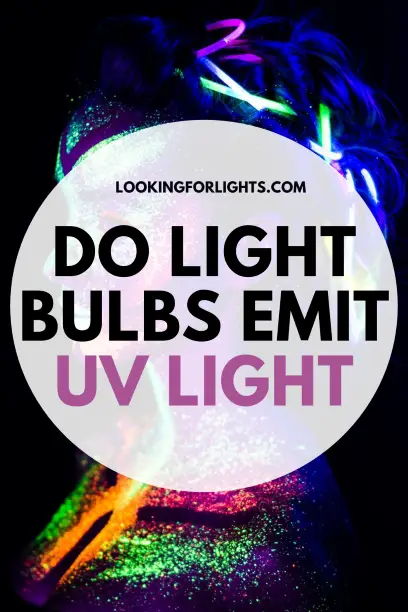
UV rays have a shorter wavelength than visible light, which makes them invisible to human eyes. UV light also has several benefits, especially when it comes to certain animals like reptiles.
Moreover, UV rays also trigger Vitamin D in our bodies, which helps our body build up the immune system. However, like everything else, overexposure to the light has dangerous consequences as well.
So do light bulbs emit UV rays? Yes, some bulbs like fluorescent bulbs, incandescent bulbs and UVB lights do emit UV rays. There are a lot of misconceptions about light bulbs today, which cause many people to buy the wrong ones for their needs. Almost everything you use today has benefits and risks.
There is no way to completely prevent the negative consequences but what we can do is go for the option that comes with minimum or negligible risk. Let’s dive a little deeper into the subject to fully understand.
Table of Contents
Do Light Bulbs Emit UV rays? Comparing Each Bulb Type
Yes, some bulbs do emit UV rays. However, the amount and intensity of UV rays emitted will vary based on the type of bulb being used. Let’s take a look at the different bulbs that generate UV radiation.
| Light Bulb | UV Rays |
|---|---|
| Incandescent Bulbs | Very small amounts of UV rays. Depends on how hot the filament is. |
| Fluorescent Bulbs (CFL bulbs and Tube Lighting) | More UV rays than incandescent bulbs, but still very small amounts. However, there is a small risk of leaks. |
| UVB Bulbs | WAY more UV rays than incandescent and fluorescent bulbs. Meant for animals only. |
| Halogen Lamps | Similar to incandescent bulbs but use bromine gas. Do NOT use if glass breaks. |
| LED bulbs | Least amount of UV rays. Safest to use. |
Incandescent Bulbs
Incandescent bulbs are still one of the most commonly used bulbs in various parts of the world despite the surge in LED light bulb popularity. Incandescent bulbs do emit UV rays but in very small amounts and therefore are impossible to have any negative consequences to one’s health. Due to the low amount of UV rays generated, they also don’t cause any sunburns or trigger the production of vitamin D in humans and animals.
Light emitted by traditional incandescent bulbs has a very broad spectrum and UV rays are a very small part of it. When it comes to these bulbs, the hotter the filament is, the more UV rays it emits. However, they are also designed to minimize UV rays, so you don’t have to worry about using them.
Fluorescent Bulbs (CFL bulbs and Tube Lighting)
Fluorescent bulbs are mostly of two different types. The compact fluorescent bulbs are used in houses and the fluorescent tube lighting is mostly operated in workplaces. In both types of fluorescent bulbs, the UV light rays are created as the electric current travels through the low-pressure mercury vapor. These rays then hit the phosphor coating inside to emit the white light that we see.
Both of them emit more UV light than incandescent bulbs but the amount is still low when it comes to causing any negative health consequences. However, the risk is high here if there is a leak. The phosphor coating blocks the leaks but when there are better bulbs, there is no reason to take any risks.
UVB Bulbs
UV rays from the sun help living organisms absorb Vitamin D and offer plenty of benefits. However, overexposure to these rays is very harmful to one’s health. While humans don’t require any UV light bulbs as we can just step outside under the sun, some animals don’t have the same freedom.
UVB bulbs are also known as reptile basking bulbs and are used in a lot of pet stores and animal exhibit venues to provide a lighting supplement to reptiles and amphibians in captivity or under observation. Some animals need UV rays to metabolize calcium and therefore require artificial lights to achieve their unique needs. UVB bulbs generate substantially higher amounts of UV rays than incandescent and fluorescent bulbs and are meant to be used for animals only.
Halogen Lamps
Halogen bulbs are mostly used by those who like the look of a normal light bulb but need a more efficient light output. They are quite similar to incandescent bulbs with the major difference being the gas that is used inside. Halogen uses bromine whereas traditional bulbs use a nitrogen-argon combination.
They provide the same soft yellow glow that an incandescent lamp does but consume less power. However, Halogen lamps also come with many cons and UV rays are one of them. This is why halogen bulbs must be used only when it’s covered with protective glass. If the glass is broken, it shouldn’t be used at all no matter what the scenario may be.
LED bulbs
This is a bit tricky because LEDs can be designed to emit any wavelength of light and that includes UV light. There is also a misconception that LEDs used for daily purposes don’t produce any UV rays. All LEDs, according to new studies, have very small amounts of UV radiation. However, the presence of phosphors in them reduces the emitted amount of radiation even more, which makes LED bulbs one of the safest to use when it comes to UV radiation. This is because the phosphors transform the UV rays to white light, which then gets emitted.
So apart from reptile basking light bulbs and tanning bulbs, almost all other light bulbs do emit UV rays but not to the amount where it becomes worrisome. Though incandescent and CFL bulbs generate only very less UV light from a practical and money-saving standpoint, no other bulb has the same efficiency as LED bulbs. Everything you use will have some risks and the best thing you can do is choose the option with the least amount of potential negative consequences.
Conclusion
If you use incandescent, halogen or fluorescent bulbs in your home or place of business, it may be time to switch to LEDs. Though these bulbs emit very little amounts of UV light, they are still more than LED bulbs. Apart from health consequences, CFL and HID lamps have also been found to damage shades, carpets, and painted surfaces like walls due to their UV light emissions.
Due to this reason, many museums from all over the world have started using LED bulbs for their displays. When you take safety, power consumption, quality of light, and value for money, there are no light bulbs that can match an LED bulb. What the future will hold, no one can say but right now, the best option would be to go for LED light bulbs.
